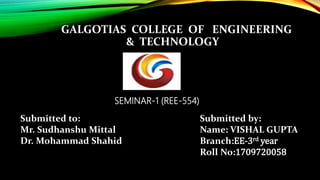
Led lightning of energy efficiency
- 1. GALGOTIAS COLLEGE OF ENGINEERING & TECHNOLOGY SEMINAR-1 (REE-554) Submitted to: Mr. Sudhanshu Mittal Dr. Mohammad Shahid Submitted by: Name: VISHAL GUPTA Branch:EE-3rd year Roll No:1709720058
- 2. LED LIGHTNING THE FUTURE IS NOW SAVE MONEY.SAVE ENERGY.IMPROVE LIGHTING QUALITY
- 3. CONTENTS •EVOLUTION OF LIGHTNING •DEFINE EFFICIENCY •WONDERS OF LED •HOW LEDS ARE DIFFERENT •IMAGES OF SOME LED LAMPS •COMPARISON •ADVANTAGES •APPLICATIONS •REFERENCE
- 4. EVOLUTION OF LIGHTNING Incandescent bulbs, which are now considered as “heaters”, generate 95% heat and accidentally give out light. Fluorescent tube light ( T12 SERIES) CFL’s (5W , 9W ,11W) LED’S( RED , , GREEN , WHITE) ORGANIC LED
- 5. FLUORESCENT TO LED’SFluorescent tube lights have been therefor years and would continue to be in use for the next couple of years Fluorescent tube light’s major draw back is that they contain mercury which is non- biodegradable Fluorescent tube light also emit UV radiations
- 6. ORGANIC LED An Organic Light Emitting Diode (OLED), is a Light Emitting Diode (LED) whose emissive electroluminescent layer is composed of a film of organic compounds. The layer usually contains a polymer substance that allows suitable organic compounds to be deposited. They are deposited in rows and columns onto a flat carrier by a simple "printing" process. The resulting matrix of pixels can emit light of different colors. Such systems can be used in television screens, computer displays, small portable system screens such as cell phones and PDAs, advertising, information and indication. OLEDs typically emit less light per area than inorganic solid-state based LEDs.
- 7. DEFINE EFFICIENCY • How well you can convert one thing to another • In lighting we convert ELECTRICITY into LIGHT • What is ELECTRICITY?—(Watt) Energy from (Wind power, solar ,fossils) • What is LIGHT?—Energy that causes a visual sensation to humans • LUMENS , CANDELA, LUX • So we are converting one form of energy to another • Efficiency is comparative tool, Not an absolute measure
- 8. WONDERS OF LED A Light Emitting Diode (LED) is one of the latest inventions and is extensively used these days. From your cell phone to the large advertising display boards, the wide range of applications of these magical light bulbs can be witnessed almost everywhere.
- 9. WHAT IS IT As is evident from its name, LED (Light Emitting Diode) is basically a small light emitting device that comes under “active” semiconductor electronic components. It’s quite comparable to the normal general-purpose diode, with the only big difference being its capability to emit light in different colors. Working Principle: It is a p–n junction diode that emits light when activated. When a suitable voltage is applied to the leads, electrons are able to recombine with electron holes within the device, releasing energy in the form of photons . The material used in LEDs is basically aluminum-gallium-arsenide .
- 10. HOW LEDS ARE DIFFERENT LED lighting is very different from other lighting sources such as incandescent bulbs and CFLs. Key differences include the following: Light Source: LEDs are the size of a fleck of pepper, and a mix of red, green, and blue LEDs is typically used to make white light. Direction: LEDs emit light in a specific direction, reducing the need for reflectors and diffusers that can trap light. This feature makes LEDs more efficient for many uses such as recessed downlights and task lighting. Heat: LEDs emit very little heat. In comparison, incandescent bulbs release 90% of their energy as heat and CFLs release about 80% of their energy as heat.
- 12. SOME LEDS
- 13. COMPARISON
- 14. ADVANTAGES • Tremendous energy savings up to 90% • Over a lifetime , fewer light bulbs need to be used • LED do not contain any hazardous materials and therefore do not generate any wastes. • LEDS light bulbs can be recycled • LED light bulbs do not flicker , do not cause RF interference , are much easier on the eyes. • LEDS can emit light of intended colour without using any colour filters as traditional lighting methods
- 15. THE FUTURE OF LED LED is the future of lighting the lumens/watt of LEDs would increase Cleaner and safe source of lighting the cost of LEDs would further reduce Life of the LEDs would increase Organic LEDs looks to be the future for displays
- 16. APPLICATIONS IN MOTOR VEHICLES AND BICYCLE LIGHTS IN TRAFFIC LIGHT IN INDICATORS , SIGNS AND SIGNALS IN DATA DISPLAYING BOARDS IN MEDICALS DISPLAYING BOARDS REMOTE CONTROLS IN LIGHT BULBS AND MANY MORE
- 17. REFERENCE • Obtained from- www.slideshare.net/com • Obtained from - https://www.stouchlighting.com/blog/the-historical-evolution-of- lighting • Obtained from- https://energyfocus.com/blog/the-future-of-led-lighting/ • Obtained from- https://www.ledlightforyou.com/applications/index.jsp • Obtained from- https://www.youtube.com/results?search_query=led+lighting++ppt • Obtained from- https://www.currentbyge.com/ideas/8-advantages-of-led-lighting • Obtained from- https://greenie-world.com/en/article/the-disadvantages-of-led- lighting/